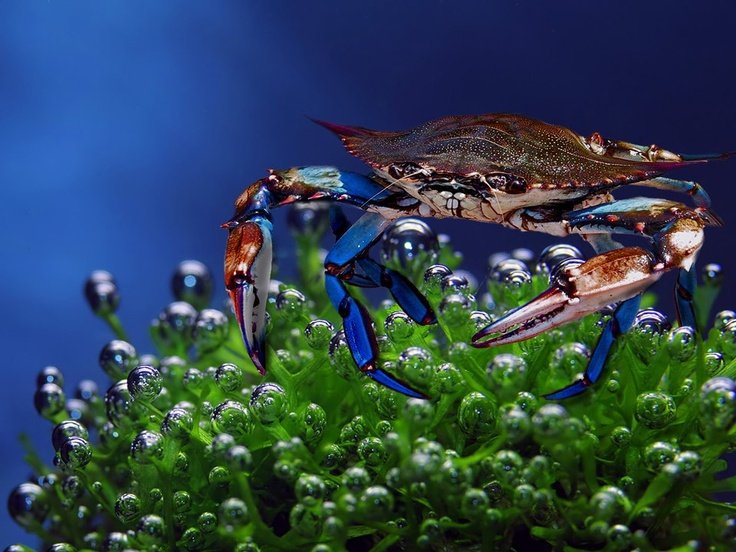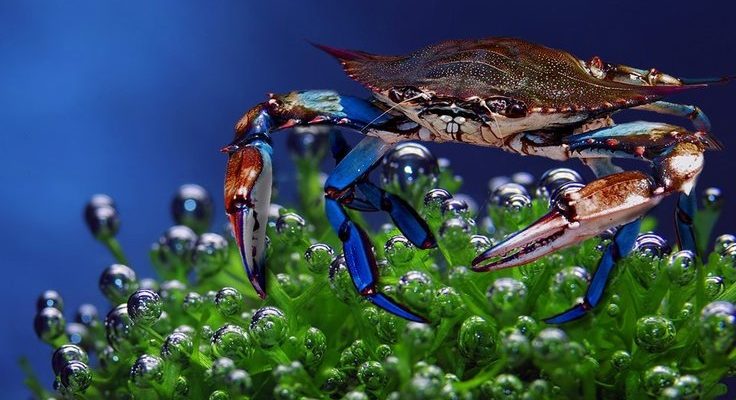
You might think of the blue crab as having superpowers of sorts. These adaptations allow them to survive and even thrive where others might struggle. Think about it like this: just as we use tools to make life easier, blue crabs have developed unique features that help them find food, evade threats, and reproduce. So, let’s dive into the specifics of how blue crabs have become the underwater champs we see today.
Body Structure and Shell Adaptations
One of the first things you might notice about blue crabs is their sturdy body structure. They have a hard shell, or carapace, that not only protects them from predators but also helps them withstand various water conditions. This tough armor is a vital adaptation for survival. But here’s the thing: it’s not just a shell; it plays multiple roles. When blue crabs grow, they actually shed this shell in a process called molting. This allows them to increase in size and ensures they can continue to thrive in their environment.
Their body shape is also designed for efficiency. With a broad, flat carapace, blue crabs can easily navigate through underwater grasses and sandy bottoms. This shape helps them hide from hungry predators, like fish and birds, while they hunt for food. Speaking of food, blue crabs are considered omnivores, meaning they eat both plants and animals. This makes them incredibly adaptable when searching for meals, allowing them to munch on algae, mollusks, and even decomposing matter.
Coloration for Camouflage
Have you ever noticed how blue crabs have a striking blue color on their claws? While they are undeniably beautiful, this coloration serves a practical purpose too. The blue and green hues of their exoskeleton help them blend in with the underwater surroundings, making it harder for predators to spot them. This natural camouflage is crucial for their survival, especially in areas with lots of vegetation and varied backgrounds.
In shallow waters, blue crabs can be particularly vulnerable to predation. To counteract this risk, they often bury themselves in the sand or mud, using their coloring as a protective tactic. When they feel threatened or want to ambush their prey, they can quickly bury themselves, becoming nearly invisible. This clever trick means they can not only protect themselves but also set the stage to pounce on unsuspecting shrimp or small fish.
Highly Developed Sensory Organs
Blue crabs also have an impressive array of sensory organs that help them thrive underwater. Their compound eyes provide a wide field of vision, allowing them to spot potential threats from various angles. This is essential for a creature that spends its life in a constantly changing environment. With their eyes, they can detect movement from predators or find food with greater ease.
But it’s not just vision that these crabs have mastered. They have sensitive antennae and chemoreceptors that help them pick up on chemical cues in the water. This means they can sense where their next meal might be lurking or even detect potential mates. Imagine being in a crowded room and still being able to pinpoint the smell of your favorite food; that’s how adept blue crabs are at sensing their environment!
Adaptations for Mobility
Mobility is another key adaptation that helps blue crabs survive. Their ten legs are divided into specialized pairs that serve different functions. The front pair of legs, equipped with claws, is used for grabbing food and defending against threats. The other legs help them quickly scuttle away from danger or navigate through their habitats.
Blue crabs are also capable swimmers. They can move backward and sideways, which is quite handy when trying to escape a predator. Their unique swimming technique allows them to dart away in an instant, making them slippery little escape artists. This agility, combined with their ability to camouflage, makes them a tough catch for those hungry fish lurking about.
Reproductive Adaptations
When it comes to reproduction, blue crabs have some interesting adaptations too. They can reproduce in various environmental conditions, which gives them a leg up in survival. Female blue crabs carry fertilized eggs under their tails for a period before releasing them into the water. This nurturing behavior helps protect the eggs from predators and harsh environmental conditions.
Additionally, blue crabs have a unique mating ritual. Males will often compete for the attention of a female, showcasing their strength and vitality. This competitive behavior ensures that only the fittest males pass on their genes, leading to a healthier population overall. By adapting their reproductive strategies to their environment, blue crabs ensure that their species continues to thrive in the face of ever-changing conditions.
Feeding Strategies and Adaptations
An important part of thriving underwater is finding food, and blue crabs have adapted their feeding strategies to maximize their chances of success. As opportunistic feeders, they use their claws to sift through sand and mud, unearthing a variety of snacks like worms, mollusks, and algae. This versatility in diet helps them make the most of their environment, allowing them to adapt to changing food availability.
They are also known to be scavengers, meaning they’ll eat almost anything they come across. This behavior not only helps them survive during lean times but also keeps the ocean floor clean by breaking down organic matter. By filling multiple roles in their ecosystem, blue crabs contribute to the health of their underwater habitats while ensuring their own survival.
Climate Adaptations
Living in a world where temperatures can drastically change means blue crabs must also adapt to varying climates. They are often found in estuarine environments, where freshwater meets saltwater, resulting in a mix of salinity levels. Blue crabs can tolerate these changes, allowing them to thrive in different conditions. This adaptability means they can inhabit a wide range of places, from the warm coastal waters to the cooler, brackish waters of estuaries.
During colder months, blue crabs can slow their metabolism and bury themselves in the mud to survive lower temperatures. This behavior not only protects them from predators but also helps them conserve energy. When waters warm up again, they emerge, ready to feed and reproduce. This remarkable ability to cope with temperature changes showcases just how resilient they are in their aquatic environments.
In conclusion, the blue crab is a true testament to the power of adaptation in the animal kingdom. From their sturdy bodies and clever camouflage to their impressive sensory systems and flexible diets, these creatures have finely tuned their capabilities to thrive underwater. Understanding these adaptations can deepen our appreciation for the delicate balance of marine ecosystems.
Next time you see a blue crab, remember that it’s not just a tasty seafood option; it’s a master of survival in a complex underwater world. By learning about these incredible adaptations, you gain insight into not just blue crabs, but the amazing resilience of life itself. So, let’s continue to celebrate and protect these remarkable creatures and the habitats they call home.

